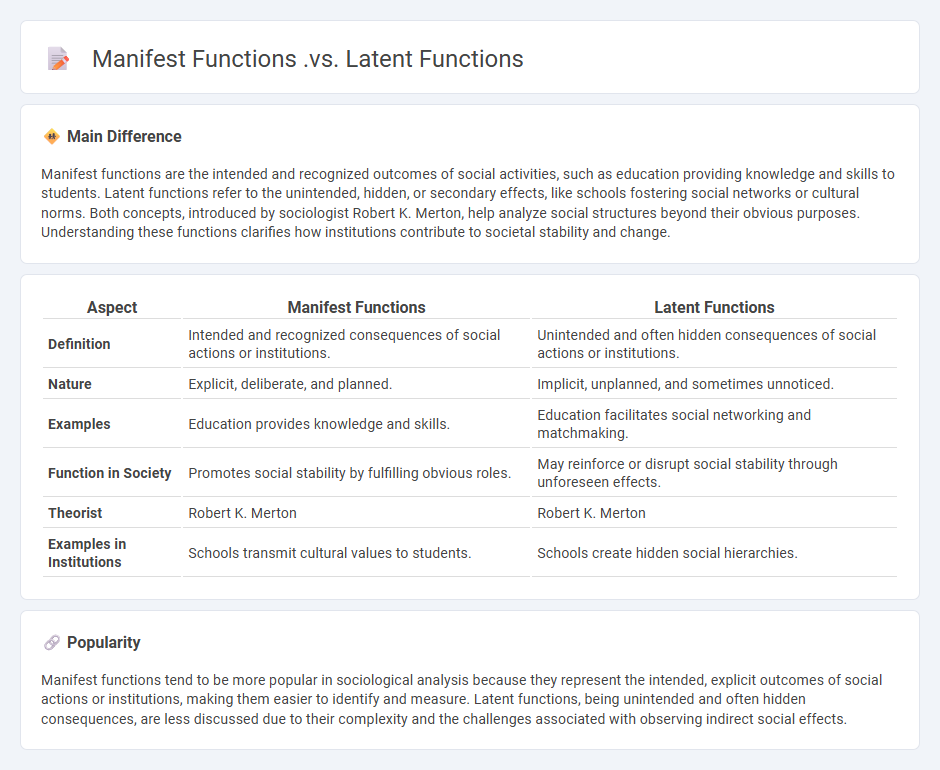
Manifest functions refer to the intended and recognized consequences of social actions or institutions, such as education promoting knowledge and skills. Latent functions are the unintended and often hidden effects, like schools fostering social networks or reinforcing social norms. Explore how understanding both functions reveals the complex impacts of societal structures.
Main Difference
Manifest functions are the intended and recognized outcomes of social activities, such as education providing knowledge and skills to students. Latent functions refer to the unintended, hidden, or secondary effects, like schools fostering social networks or cultural norms. Both concepts, introduced by sociologist Robert K. Merton, help analyze social structures beyond their obvious purposes. Understanding these functions clarifies how institutions contribute to societal stability and change.
Connection
Manifest functions are the intended and recognized consequences of social institutions or actions, while latent functions represent the unintended and hidden effects. Both functions operate simultaneously within any social structure, revealing the complex layers of social behavior and organization. Understanding their connection helps sociologists analyze how social practices contribute to both explicit goals and underlying social patterns.
Comparison Table
| Aspect | Manifest Functions | Latent Functions |
|---|---|---|
| Definition | Intended and recognized consequences of social actions or institutions. | Unintended and often hidden consequences of social actions or institutions. |
| Nature | Explicit, deliberate, and planned. | Implicit, unplanned, and sometimes unnoticed. |
| Examples | Education provides knowledge and skills. | Education facilitates social networking and matchmaking. |
| Function in Society | Promotes social stability by fulfilling obvious roles. | May reinforce or disrupt social stability through unforeseen effects. |
| Theorist | Robert K. Merton | Robert K. Merton |
| Examples in Institutions | Schools transmit cultural values to students. | Schools create hidden social hierarchies. |
Manifest Functions
Manifest functions in sociology are the recognized and intended consequences of social institutions or actions that contribute to social stability and continuity. For example, the manifest function of education is to transmit knowledge and skills to students, preparing them for future employment. These functions contrast with latent functions, which are unintended and often hidden effects. Understanding manifest functions helps sociologists analyze how society maintains order and meets its explicit goals.
Latent Functions
Latent functions in sociology refer to the unintended and often hidden consequences of social actions or institutions that contribute to social stability or change. These functions contrast with manifest functions, which are the intended and recognized outcomes of social behavior. For example, in education, a manifest function is imparting knowledge, while a latent function includes fostering social networks and cultural norms. Understanding latent functions helps sociologists analyze the complex ways institutions maintain social order beyond their explicit roles.
Intended Consequences
Intended consequences in sociology refer to the deliberate outcomes resulting from social actions, policies, or institutions designed to achieve specific goals. These are contrasted with unintended consequences, which arise without anticipation or planning. Examples include laws enacted to reduce crime rates or educational reforms aimed at improving literacy levels. Understanding intended consequences helps sociologists evaluate the effectiveness and purpose of social structures and behaviors.
Unintended Consequences
Unintended consequences in sociology refer to outcomes of social actions that are not anticipated or intended by the actors involved. Robert K. Merton's analysis categorized these consequences into unforeseen positive effects, unforeseen negative effects, and perverse results that contradict original intentions. Such consequences often arise from the complexity of social systems and the unpredictable interaction of social variables. Understanding unintended consequences is essential for analyzing social policies, institutional behaviors, and cultural practices.
Social Structure
Social structure in sociology refers to the organized patterns of relationships and social arrangements that shape society and influence individual behavior. It encompasses institutions such as family, education, religion, and government, which establish roles, norms, and hierarchies. Key concepts include social stratification, social roles, status, and social networks, all of which contribute to the stability and functioning of societies. Sociologists analyze social structure to understand how it affects inequality, social mobility, and group dynamics within communities.
Source and External Links
Define manifest and latent functions and provide examples of each using a single social institution - Manifest functions are consciously recognized and intended outcomes of social institutions, while latent functions are unintended and often unrecognized consequences that also affect society.
Manifest & Latent Function | Overview, Theory & Examples - Lesson - Manifest functions are the intended and expected results of social patterns, whereas latent functions are the unintended and often unnoticed by-products of those same patterns.
Manifest and Latent Functions in Sociology: Definition & Examples - Manifest functions refer to the deliberate, recognized outcomes of social phenomena, while latent functions are the hidden, unintended consequences that also shape society.
FAQs
What are manifest functions?
Manifest functions are the intended and recognized consequences or outcomes of a social action or institution.
What are latent functions?
Latent functions are unintended and unrecognized consequences of social actions or institutions that contribute to social stability or change.
How do manifest functions differ from latent functions?
Manifest functions are the intended and recognized consequences of social actions, while latent functions are the unintended and unrecognized outcomes.
What is an example of a manifest function?
An example of a manifest function is education providing students with knowledge and skills necessary for employment.
What is an example of a latent function?
An example of a latent function is a school's role in creating social networks among students.
Why are latent functions important in sociology?
Latent functions are important in sociology because they reveal unintended and hidden social consequences that help explain complex social dynamics and maintain social stability.
How do manifest and latent functions influence social institutions?
Manifest functions provide intended and recognized roles that promote social stability, while latent functions produce unintended and hidden effects that can reinforce or challenge social norms within social institutions.
 calledges.com
calledges.com